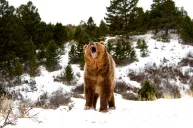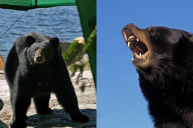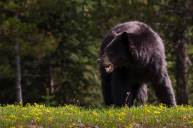If you're planning to hike, camp, or fish anywhere outside the central or south Midwest this year, chances are pretty high you'll be sharing your outdoor space with brown bears or black bears—or both!
I'm writing this article from the inside my tent, which is pitched right beyond a bear box in a heavily used state park. I'm out here with 10 kids between the ages of 12 and 15, many of whom are camping for the very first time.
The moment I explained what the strange metal box next to their shelter was—and how everything with a scent had to go into it—chaos reigned. What about deodorant? Was hand sanitizer okay? How about wet wipes? Did this mean a bear might come into our camp? If that happened, what would we do?
Luckily, I had answers, both as a backcountry guide who teaches new campers how to hike safely and as a park ranger in the bear-heavy Appalachian Mountains. In my time, I've learned a lot about these creatures and the best ways to keep yourself—and the bears—safe.
Where Do Bears Live?
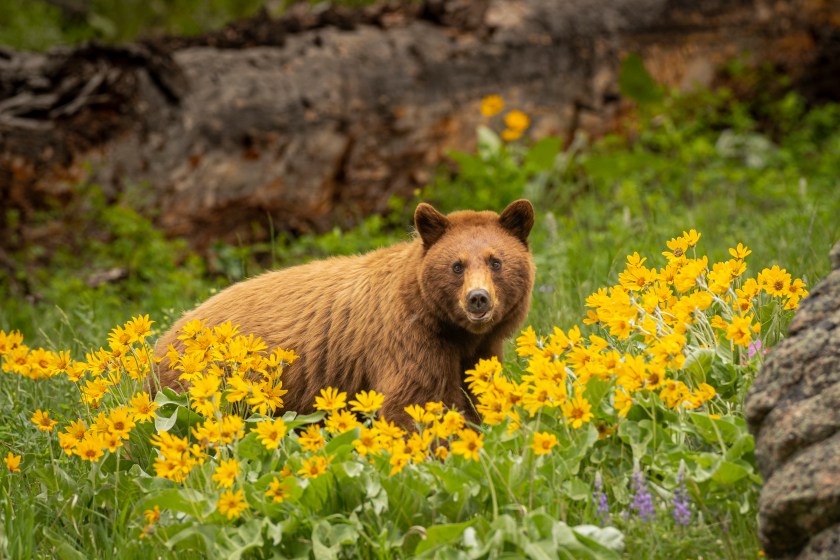
Dennis Stogsdill/Getty Images
The United States is full of bear habitat, even in places you might not expect like the Outer Banks of North Carolina. The American black bear is the most common species, with approximately 600,000 living throughout North America, according to Bear Aware, a Montana-based conservation organization that focuses on bear safety and awareness. They are mostly found in forested and mountainous areas, especially along the spine of the Appalachian Mountains in the East and around the Rocky Mountains in the West.
Brown bears, on the other hand, are much less common. There are only around 30,000 brown bears in the United States, and most of them are concentrated in Alaska, with a smaller amount in rural regions of Wyoming, Montana, and Idaho, and Washington—these inland bears are commonly known as "grizzlies." While the terms "brown bear" and "grizzly" refer to the same species, geographic location and access to abundant food (i.e., salmon) means that Alaskan brown bears are often a bit heftier than their inland "grizzly" cousins.
What's the Difference Between Brown and Black Bears?
Black Bears

KeithBinns/Getty Images
Unless you're in Alaska or remote areas of the Pacific Northwest or northern Rockies, chances are any bear you see is going to be a black bear. Here's how to tell:
Found in: Heavily forested areas across the U.S.
Diet: A black bear's diet consists primarily of roots and berries, though they will eat small mammals and carrion, too. Curious and intelligent, these are the bears most associated with pilfering picnic baskets, rummaging in trash cans, and generally messing with any and all accessible food sources.
Features: Black bears typically:
- Are smaller than brown bears
- Are excellent swimmers and climbers
- Have fur that is primarily black or dark brown, often with a lighter patch around their eyes and nose
- Have s longer face with a pointy snout
Brown Bears

Thomas Faull/Getty Images
In the U.S., brown bears (including grizzlies) mostly only live in Alaska and remote areas of the Pacific Northwest.
Found in: Brown bears stick to remote areas of the country, usually Alaska, the Pacific Northwest, and, less frequently, Montana and Wyoming.
Diet: Brown bears, on the other hand, tend to avoid development and go after larger prey. In coastal areas, they subsist on salmon, but inland bears will also eat wolves, elk, moose, and bison. They complement their diet with roots, berries, insects, carrion, grasses, and leaves.
Features: Brown bears typically:
- Are much larger than black bears
- Can be more aggressive
- Come in a range of colors other than brown, including black, cinnamon, and blonde.
- Have a distinctive hump between their shoulder blades
- Have long claws
- Have a wide, round-shaped face
How Can I Protect Myself from Bears?
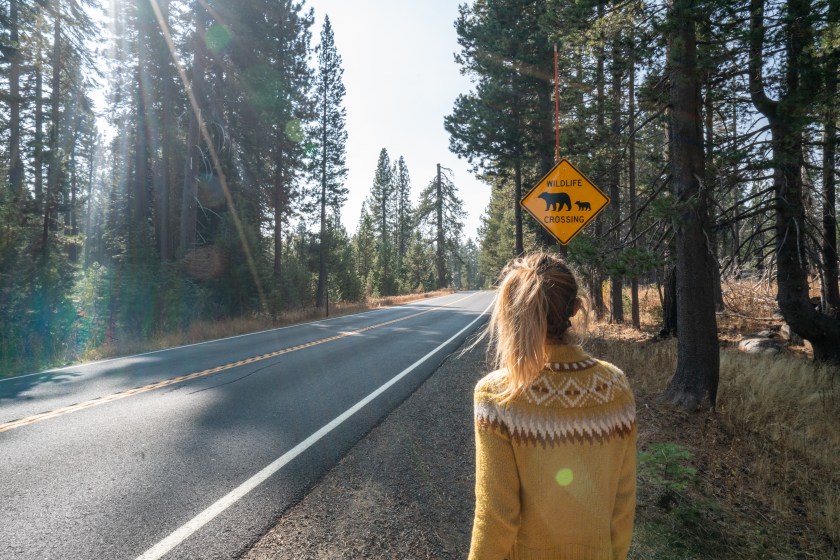
swissmediavision/Getty Images
Due to their abundance, encounters with black bears occasionally occur; however, black bears are generally much more interested in your food than they are in you—and, thankfully, you don't count as food.
Interactions with brown bears are exceedingly rare, thanks to their remote and isolated habitat. Still, there are several precautions you should take to reduce the likelihood of any human-bear interaction.
Never approach or feed bears: Feeding bears (on purpose or accidentally) encourages them to associate people with food, which can result in unnecessary confrontations. If you see a bear, never approach it. Make noise and extend your arms or hiking poles in order to look as large as possible to scare the bear away.
Secure food, toiletries, and garbage: If you're camping in an established campground frequented by bears, you'll most likely have access to a bear box. This steel contraption is large enough to store personal items away from prying paws. If you're hiking in the backcountry, you can bring your own mini version, called a bear canister, or you can do a "bear hang," which involves hanging your food bag from a tree branch in the air high enough that it cannot be reached.
Cook and eat away from camp, if possible: In grizzly territory, hikers should always eat their meals away from camp to reduce tempting smells near sleeping locations. Wherever you roam, cook, eat, and clean a few miles before you set up camp for the night, then secure the rest of your food via a bear hang, or walk your bear canister far enough away to discourage midnight visitors. Be sure to check packs and pockets for stowaway snacks and wrappers you may have forgotten about throughout the day.
Make noise: Bears are easily startled by loud noises. Traveling in groups is one of the best ways to avoid a confrontation. If you're hiking alone, occasionally clap or yell to make your presence known.
Carry bear spray when necessary: In grizzly territory, bear spray is a must, especially for extended trips in the backcountry. Bear spray is a super-charged pepper spray that comes in a large container to pack a wallop in the event it's discharged. Many outdoor outfitters sell bear spray; however, it's not allowed on airlines, so it might be best to wait until you've arrived at your destination before making a purchase.
Once you have the spray, don't just toss it in your bag. Always keep the canister hooked on a belt loop, in a front pocket, or in a fanny pack where it's easily accessible. Though an item of last resort, bear spray is pretty darn effective when used correctly.
How You Should Act if a Bear Charges You
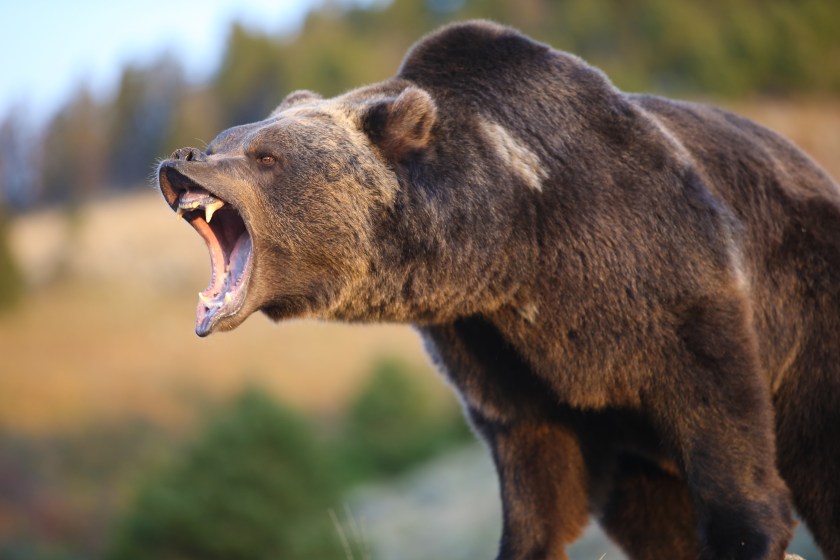
through-my-lens/Getty Images
In the unlikely event that a bear charges or attacks, there are a few key things to know.
For starters, if you have a pack, leave it on for additional protection.
If it's a black bear:
1. Lie face-down on the ground and play dead.
2. If the bear does not leave after several minutes, fight back.
If it's a brown bear, including a grizzly:
3. Immediately deploy your bear spray.
4. If the bear is undeterred, fight back, aiming for the eyes and face.
How Can I Protect My Dog from Bears?
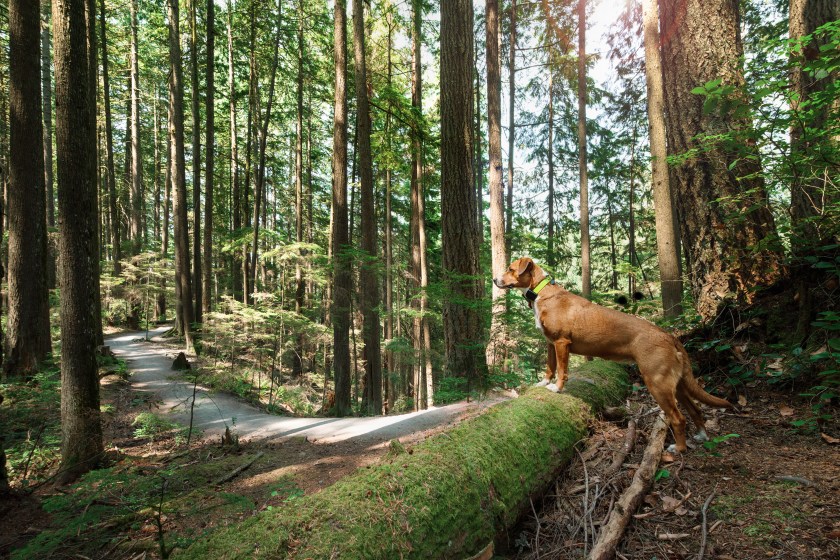
Petra Richli/Getty Images
Dogs can be great companions in the backcountry, but they also bring some additional challenges. Dogs have innate curiosity and an impeccable sense of smell, so it's not uncommon for them to seek out wildlife, including bears, long before their owners are aware of what's happening.
Quiet or quick-moving dogs often startle bears, which can trigger an attack. Because dogs cannot fend for themselves against a bear, it's up to their owners to make sure they stay safe in bear country. That means always using a leash on the trail or a tether at camp when your dog isn't inside your tent.
Just like your food, your dog's food needs to be packed and properly stored to reduce the likelihood of accidentally feeding a bear.
READ MORE: Hiking in Rattlesnake Country: How to Stay Safe and What to Do if You Get Bit

